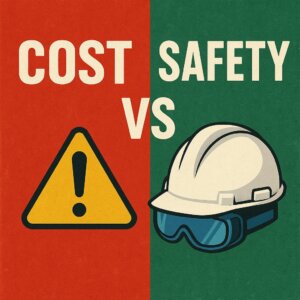In many work environments, the use of personal protective equipment (PPE) is essential for effectively reducing potential occupational risks. However, some employees still choose not to wear these protective items. This article will analyze the main reasons for this phenomenon and propose corresponding solutions to enhance employees’ safety awareness and participation.
1. Discomfort—The Importance of Comfort
Employees commonly report that the comfort of PPE is a key factor influencing their willingness to wear it. Overly tight protective clothing or ill-fitting safety shoes can make employees uncomfortable during work. For example, one employee chose not to wear protective gloves because they were too thick, which led to a minor injury. This highlights that ensuring the comfort of PPE is crucial for increasing compliance.
2. Perceived Unnecessity—Eliminating Misconceptions
Some employees may mistakenly believe that wearing PPE is unnecessary due to their assessment of the work environment. They often think, “Accidents won’t happen to me.” To address this issue, companies need to provide regular safety education to help employees understand potential risks and the importance of PPE, thereby changing their perception.
3. Poor Fit—The Issue of Adaptability
Different employees have varying body types and work requirements, yet some PPE designs may not take this into account. For instance, a single size of protective clothing may not fit all employees’ needs. Companies should consider the diverse requirements of their workforce when procuring PPE to provide better options.
4. Lack of Training and Awareness—The Importance of Education
A lack of understanding regarding the use and importance of PPE can also be a problem. One company significantly improved employees’ safety awareness by hosting training sessions that included real-life case studies. The use of simulations allowed employees not only to learn the correct use of PPE but also to enhance their practical skills.
5. Psychological Factors—The Impact of Psychological Barriers
Some employees resist wearing PPE due to psychological factors, such as fear or self-doubt. In high-risk environments, they may feel that wearing PPE makes them appear weak. Companies can help alleviate employees’ anxiety through psychological counseling and team-building activities, thereby enhancing collective cohesion.
6. Habitual Neglect—Cultivating Good Habits
In the workplace, employees may gradually develop a habit of neglecting PPE. For example, at a construction site, the absence of accident warnings led employees to think, “Nothing will happen.” Companies should conduct regular safety checks to remind employees to stay vigilant and cultivate the habit of wearing PPE.
7. Insufficient Equipment Maintenance—The Necessity of Maintenance Mechanisms
Some PPE may become damaged due to a lack of maintenance, resulting in employees being unwilling to use it. For instance, broken goggles or worn-out protective clothing cannot provide effective protection. Companies need to establish maintenance and replacement mechanisms to ensure all PPE is always in usable condition, thereby enhancing employees’ trust.
8. Peer Influence—Establishing a Positive Culture
Peer behavior significantly impacts employees’ PPE-wearing habits. If coworkers generally do not wear PPE, others are likely to follow suit. Companies can encourage safety role models by promoting compliance among management and proactive employees, thereby enhancing overall adherence.
Data Support
Surveys indicate that about 30% of employees refuse to wear PPE due to discomfort, while 40% believe it is unnecessary. By improving PPE design and enhancing training, companies can significantly reduce the incidence of accidents.
Call to Action
We encourage all employees to actively participate in building a safety culture by sharing their thoughts and experiences with PPE. By working together, we can create a safer work environment where every employee can work efficiently under safe conditions.








